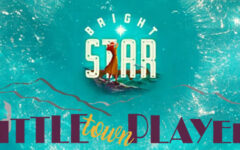 From October 1, 2010 through to the end of September 2011, we will, each day, celebrate the life of Bill Monroe by sharing information about him and those people who are associated with his life and music career. This information will include births and deaths; recording sessions; single, LP and CD release dates; and other interesting tidbits. Richard F. Thompson is responsible for the research and compilation of this information. We invite readers to share any tidbits, photos or memories you would like us to include.
From October 1, 2010 through to the end of September 2011, we will, each day, celebrate the life of Bill Monroe by sharing information about him and those people who are associated with his life and music career. This information will include births and deaths; recording sessions; single, LP and CD release dates; and other interesting tidbits. Richard F. Thompson is responsible for the research and compilation of this information. We invite readers to share any tidbits, photos or memories you would like us to include.
- July 19, 1954 Sun Records released Elvis Presley’s first single: That’s All Right (Mama) coupled with his own arrangement of Bill Monroe’s song Blue Moon of Kentucky (Sun 209), transforming Monroe’s slow waltz into an upbeat, blues-flavored tune in 4/4 time.
- July 19, 1954 Paul Sato was born in Honolulu, Hawaii. *
- July 19, 1973 Gregg Kennedy joined the Blue Grass Boys. He played bass for Bill Monroe for about a year.
- July 19, 1994 CD released – The Music of Bill Monroe – From 1936 To 1994 (MCA 11048) **
* Normally a banjo player, Paul Sato filled in, playing bass, with the Blue Grass Boys at a concert at the University of Hawaii‘s East-West Center in Honolulu, Hawaii; October 17, 1984.
Sato has been a mainstay on the Hawai’i bluegrass scene for many years. Currently he plays with the Saloon Pilots.
Here he relates the circumstances surrounding his fill-in job with Monroe ….
“Bill and the Blue Grass Boys performed in Hawaii on their way to Japan in October 1984. Kenny Baker had quit Monroe (on stage if I’m not mistaken) just prior to the trip. With the lack of time to find a replacement bass player, Tater Tate who was playing bass with Monroe was ‘bumped over’ to take Kenny’s place on fiddle (I believe that Tater was experiencing shoulder problems at the time that made it difficult for him to play the fiddle, hence his stint on the bass).
On their arrival at the Honolulu International Airport where I was one of a number of people who greeted Mr. Bill and the Boys, I was approached by the road manager (Tony Conway) and asked if I would be willing to play bass for the performance. I can’t recall how he learned that I played the upright bass as I was playing the banjo in the band scheduled to open for the Blue Grass Boys for that concert.
I consented (with a lot of self-doubt) and for all of the next day, spent my time with Wayne Lewis and Blake Williams. (Mr. Bill had made the acquaintance of a woman and was off touring the island with her, with Tater in-tow)
I was concerned about the performance, and every time I would ask Wayne about getting a set list or practicing he would reply: ‘Aw, you know these songs better than we do….’ Not making me feel very confident in the least.
On the day of the concert Mr. Bill was scheduled to give a press conference. Wayne went along for support, and in the event that Mr. Bill might need assistance with some of the questions the press might ask. (Mr. Bill required no assistance, he handled every question beautifully). Wayne asked me to come along too.
At one point, someone in the audience stated that they knew Mr. Bill was a former professional dancer, and would he mind showing the crowd some of his steps? The crowd went wild and Mr. Bill consented.
Here’s the cool part…Mr. Bill uncases his 1923 Gibson F5 Loar mandolin, holds it up and asks: ‘Can somebody play this?’ Wayne and I look at each other, but in the meantime an audience member bounds up onstage and says that he can play it. He plays Sally Goodin while Mr. Bill goes through his paces as smooth as silk. Again, the crowd goes wild.
Later that evening just before the concert (the place was packed beyond capacity), Wayne hands me a handwritten set list and tells me ‘we might do these…’. Luckily, I knew the songs; Monroe classics, but I’m still nervous nonetheless.
I played the banjo in the opening band then hurried to the dressing room to change into my suit and hat. (Blue Grass Boys; even ‘Fill-ins’ must wear a hat)
Other than a sound problem on the opening tune, everything goes well providing me with the musical experience of a lifetime.
Mr. Bill did not speak to me until just before the concert. He did say several things to me that I’ll never forget as long as I live (I should write them down sometime, as well as the detailed events surrounding the concert).
Just before the Blue Grass Boys’ concert was to begin, I rode down in the elevator with Bill and Wayne Lewis to the stage on the main floor. I was standing to the rear of the elevator behind the both of them; in dead silence. I felt the need to say something, so as the elevator door opened I said ‘Bill, I want you to know that I’m going to do my best for you tonight.’ He turned, looked me in the eye and said ‘Son, you had better,’ then turned and walked towards the stage. I broke out in a sweat.”
** The Music of Bill Monroe – From 1936 To 1994, 4 CD set in book format
It’s the rare artist who virtually invents a genre single-handedly, and there’s no artist in any genre whose work has remained as dominant a force as Bill Monroe. The songs here not only define bluegrass, they remain the core of any bluegrass band’s repertoire. Monroe added a dose of sophistication to traditional hillbilly music–intricate group harmonies, expert musicianship–and he rehearsed his Blue Grass Boys for hours on end. MCA’s lavish 4 CD set covers 60 years and 98 songs, adding detailed notes and anecdotes. Beginning with 1936 duets with brother Charlie, the list of Blue Grass Boys reads like a roster of legends: Flatt and Scruggs, Chubby Wise, Mac Wiseman, Jimmy Martin, Vassar Clements, Sonny Osborne, Bobby Hicks, Kenny Baker, Bill Keith, Del McCoury, Peter Rowan, and Richard Greene; the list goes on and on, as does the legacy of Monroe’s music.
Marc Greilsamer
Track listing – My Long Journey Home (The Monroe Brothers), What Would You Give In Exchange For Your Soul (The Monroe Brothers), Mule Skinner Blues, Cryin’ Holy Unto My Lord, Back Up And Push, Goodbye Old Pal, Heavy Traffic Ahead, Wicked Path Of Sin, It’s Mighty Dark To Travel, Bluegrass Breakdown, Can’t You Hear Me Callin’, My Little Georgia Rose, I’m On My Way To The Old Home, I’m Blue, I’m Lonesome, Uncle Pen, Lord Protect My Soul, Raw Hide, Brakeman’s Blues, Sugar Coated Love, Christmas Time’s A Coming, The First Whippoorwill, In The Pines, Footprints In The Snow and Walking In Jerusalem
Memories Of Mother & Dad The Little Girl & The Dreadful Snake, Y’all Come Sitting Alone In The Moonlight On And On White House Blues Happy On My Way A Voice From On, High Close By, Put My Little Shoes Away, Wheel Hoss, Cheyenne, You’ll Find Her Name Written There, Roanoke, Blue Moon Of Kentucky, The Girl In The Blue Velvet Band, Used To Be, A Good Woman’s Love, Cry, Cry Darlin’, I’m Sittin’ On Top Of The World, I’ll Meet You In The Morning, Scotland, Molly And Tenbrooks and John Henry
Big Mon, Dark As The Night, Blue As The Day, Sold Down The River, Little Joe, Lonesome Road Blues, I’m Going Back To Old Kentucky, Toy Heart, Nine Pound Hammer, Big Sandy River, Darling Corey, Salt Creek, Sailor’s Hornpipe, Roll On Buddy, Roll On, Bill’s Dream, Never Again, Dusty Miller, Midnight On The Stormy Deep, Soldier’s Joy, Blue Night, Sally Goodin, Kentucky Mandolin, Walls Of Time, I Haven’t Seen Mary In Years, The Dead March, With Body And Soul, Walk Softly On My Heart and Goin’ Up Caney
Kentucky Waltz, Get Up John, Lonesome Moonlight Waltz, Rocky Road Blues, Jenny Lynn, My Old Kentucky And You, You Won’t Be Satisfied That Way, Jerusalem Ridge, Ashland Breakdown, Come Hither To Go Yonder, My Last Days On Earth, My Sweet Blue-Eyed Darlin’, Travelin’ This Lonesome Road, The Old Brown County Barn, Stay Away From Me, The Long Bow, The Old Cross Roads, Southern Flavor, Take Courage Un’ Tomorrow, Pike County Breakdown, I’m Working On A Building, You’re Drifting Away and Boston Boy.







